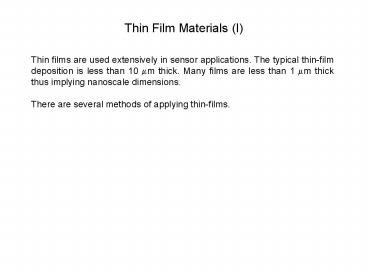Thin Film Materials (I) - PowerPoint PPT Presentation
1 / 22
Title:
Thin Film Materials (I)
Description:
Thin Film Materials (I) Thin films are used extensively in sensor applications. The typical thin-film deposition is less than 10 m thick. Many films are less than ... – PowerPoint PPT presentation
Number of Views:810
Avg rating:3.0/5.0
Title: Thin Film Materials (I)
1
Thin Film Materials (I)
Thin films are used extensively in sensor
applications. The typical thin-film deposition is
less than 10 ?m thick. Many films are less than 1
?m thick thus implying nanoscale
dimensions. There are several methods of
applying thin-films.
2
- Physical vapor deposition
- Chemical vapor deposition
- Electrodeposition
- Langmuir-Blodgett
3
Physical Vapor Deposition
- Evaporative Vapor Deposition
- Electron Beam Deposition
- Sputter Deposition
- Cathodic Arc Deposition
- Pulsed Laser Deposition
4
Physical Vapor Deposition
- Always performed in vacuum.
- Vacuum increases mean free path of ions or atoms.
- Chemical reactions do not occur in the process.
- Vacuum is typically less than 104 Torr.
- Substantial investment required for equipment.
- Radial deposition outward from source.
5
Evaporative Deposition
- Resistive process heats metal above BP.
- Uses low vacuum, typically 10-4 Torr.
- Low voltage, high current (Joule heating).
- Metal is placed in tungsten boat and heated.
- Most economical of all vacuum processes.
6
Electron Beam Deposition
- Electron beam heats metal above BP.
- Uses high vacuum, typically 10-6 Torr.
- Requires electron source.
- Metal is placed in graphite crucible and
bombarded. - Somewhat economical of all vacuum processes.
7
Sputter Deposition
- Plasma discharge creates metal ions.
- DC magnetron generates plasma using argon gas.
- Requires high vacuum, 10-6 Torr.
- Requires small argon pressure, 10-3 Torr.
8
Cathodic Arc Deposition
- Electric arc vaporizes metals from cathode.
- High current, generates very hot arc.
- Requires low vacuum, 10-4 Torr.
- Simple process, can be done with metal rods.
9
Pulsed Laser Deposition
- High-power laser ablates target.
- Vapor deposition occurs in plasma plume.
- Requires high vacuum, 10-5 Torr.
- Expensive vacuum system.
10
Chemical Vapor Deposition
- Chemical reaction occurs at substrate surface.
- Chemical reaction typically forms bonds at
substrate. - Cost effective, excellent for large-scale
production. - Also useful for experimental research.
- Typically used for semiconductor wafer
processing. - Typically used in silicon photovoltaic processing.
11
Chemical Vapor Deposition
- Several CVD methods exist.
- Classified by pressure / vacuum level.
- Classified by technology.
12
Chemical Vapor Deposition
- Deposition of polycrystalline Si on oxide
substrates. - Low pressure CVD (LPCVD).
- Typically 600 C.
SiH4 ? Si 2 H2 (silane)
13
Chemical Vapor Deposition
- Deposition of silicon dioxide on substrates.
- Low pressure CVD (LPCVD).
- Typically 900 C.
SiH4 O2 ? SiO2 2 H2
(silane) SiCl2H2 2 N2O ? SiO2 2 N2
2 HCl (dichlorosilane) Si(OC2H5)4 ? SiO2
byproducts (tetraorthosilicate)
14
Chemical Vapor Deposition
- Deposition of silicon dioxide on substrates.
- Low pressure CVD (LPCVD).
- Typically 900 C.
SiH4 O2 ? SiO2 2 H2
(silane) SiCl2H2 2 N2O ? SiO2 2 N2
2 HCl (dichlorosilane) Si(OC2H5)4 ? SiO2
byproducts (tetraorthosilicate)
15
Chemical Vapor Deposition
- Deposition of metals on substrates.
- Copper or aluminum for bus structures.
- Metal halides are typical precursors.
2MCl5 5H2 ? 2M 10HCl
WF6 ? W 3F2 WF6 3H2 ? W 6HF
16
Chemical Vapor Deposition
- Plasma enhanced CVD (PECVD).
- Plasma / ionization catalyzes reactions.
- Lower temperatures can be used.
17
Chemical Vapor Deposition
- Hot-wall thermal CVD (HWCVD).
- Large barrel holds wafers / substrates.
- High temperatures (1000 C).
18
Chemical Vapor Deposition
- Metalorganic CVD (MOCVD).
- Metal ion bound to organic ligand.
- Ligands are typically low MW methyl, ethyl
19
Electrodeposition
- Chemical reaction using electrolytes,
electroplating. - Ions in solution.
- Reactions occur at electrodes.
- Nernst behavior.
- Two coupled half-cell reactions.
- Voltage source needed to drive reaction.
Ecell E0cell - (RT/nF)lnQ
20
Electrodeposition
- Basic chemistry concepts, but complicated
kinetics. - Typical two-electrode system is simple.
21
Electrodeposition
- Three-electrode system uses potentiostat.
- Precise control of process.
22
Langmuir-Blodgett Deposition
- Deposition of organic layers.
- Successive formation of monolayers by dipping,
removing and drying and repeating. - Initially studied by Benjamin Franklin.
- Used for applying biomolecules on sensor
substrates.































